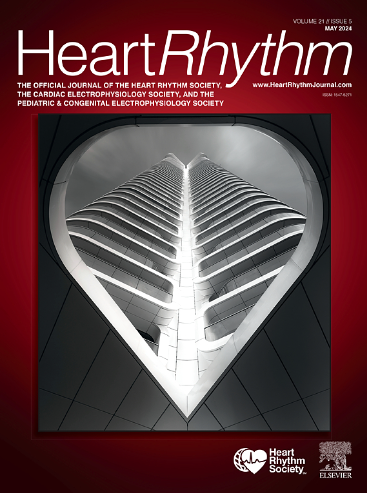严重二尖瓣反流患者心房颤动的导管消融:系统回顾与元分析》。
IF 5.6
2区 医学
Q1 CARDIAC & CARDIOVASCULAR SYSTEMS
引用次数: 0
摘要
背景:心房颤动(房颤)通常与心脏结构异常有关,包括二尖瓣反流(MR)。当代指南建议考虑早期节律控制策略,包括房颤导管消融术(CA)。然而,不同的研究和患者群体对导管消融术的长期疗效存在很大差异,而且并存的二尖瓣反流对房颤复发的影响仍不清楚:确定定义为≥中度的显著 MR 对 CA 后房颤复发率的影响,以及房颤 CA 是否与 MR 严重程度的显著变化相关:方法:系统检索PubMed、EMBASE、Web of Science和Cochrane数据库中截至2023年12月31日发表的所有英文研究:结果:共有 17 项研究(N= 2624 名患者)被纳入荟萃分析。基线有明显 MR 的患者房颤术后复发的汇总比例为 36% (95% CI 27 %-46%),而无 MR 患者的复发比例为 27% (14%-41%)。存在明显 MR 的 CA 后房颤复发的汇总危险比(95% CI)为 2.47 (1.52 - 4.01),P 结论:基线明显 MR 可独立预测 CA 后房颤复发率。尽管 CA 后房颤复发率增加与显著 MR 有关,但维持窦性心律的 CA 似乎改善了 MR 的严重程度,这表明可能诱导了反向正性心房和二尖瓣重塑。本文章由计算机程序翻译,如有差异,请以英文原文为准。

Catheter ablation for atrial fibrillation in patients with significant mitral regurgitation: A systematic review and meta-analysis
Background
Atrial fibrillation (AF) is commonly associated with cardiac structural abnormalities including mitral regurgitation (MR). Contemporary guidelines recommend consideration of early rhythm control strategies including catheter ablation (CA) for AF. However, the long-term efficacy of CA is highly variable across studies and patient populations, and the effect of coexisting MR on AF recurrence remains unclear.
Objective
A systematic review and meta-analysis was performed to determine the impact of significant MR (defined as ≥moderate) on AF recurrence rate after CA and whether CA for AF is associated with significant changes in the severity of MR.
Methods
A systematic search of PubMed, Embase, Web of Science, and Cochrane databases for all English-language studies published to December 31, 2023, was performed.
Results
A total of 17 studies (N = 2624 patients) were retained for meta-analysis. The pooled recurrence proportion of AF after CA in patients with baseline significant MR was 36% (95% CI, 27%–46%) compared with 27% (14%–41%) in patients without. The pooled hazard ratio (95% CI) for AF recurrence after CA in the presence of significant MR was 2.47 (1.52–4.01; P < .001; Egger test P value, .0583). The pooled proportion of patients who witnessed MR improvement to nonsignificant (ie, <moderate) or resolution after CA was 46 % (95% CI, 30%–62%).
Conclusion
Baseline significant MR was independently predictive of AF recurrence rate after CA. Despite the increased AF recurrence rates after CA associated with significant MR, CA with maintenance of sinus rhythm appeared to improve the severity of MR, suggesting a possible induction of reverse positive atrial and mitral valvular remodeling.
求助全文
通过发布文献求助,成功后即可免费获取论文全文。
去求助
来源期刊

Heart rhythm
医学-心血管系统
CiteScore
10.50
自引率
5.50%
发文量
1465
审稿时长
24 days
期刊介绍:
HeartRhythm, the official Journal of the Heart Rhythm Society and the Cardiac Electrophysiology Society, is a unique journal for fundamental discovery and clinical applicability.
HeartRhythm integrates the entire cardiac electrophysiology (EP) community from basic and clinical academic researchers, private practitioners, engineers, allied professionals, industry, and trainees, all of whom are vital and interdependent members of our EP community.
The Heart Rhythm Society is the international leader in science, education, and advocacy for cardiac arrhythmia professionals and patients, and the primary information resource on heart rhythm disorders. Its mission is to improve the care of patients by promoting research, education, and optimal health care policies and standards.
 求助内容:
求助内容: 应助结果提醒方式:
应助结果提醒方式:


